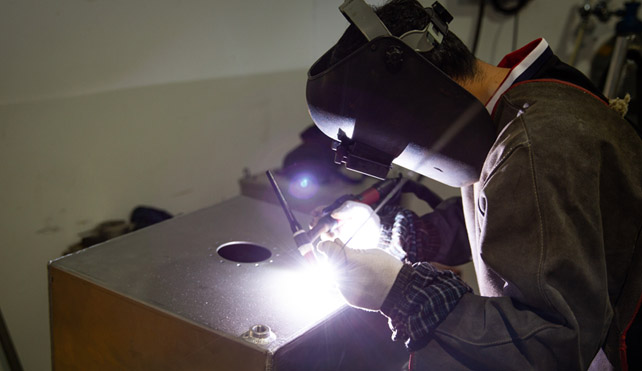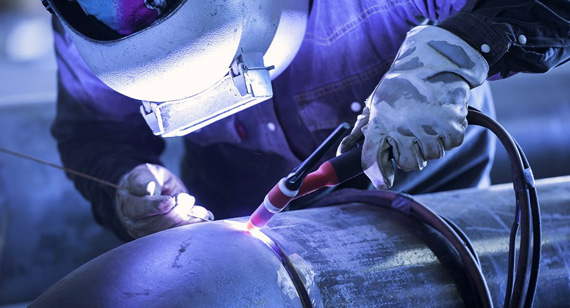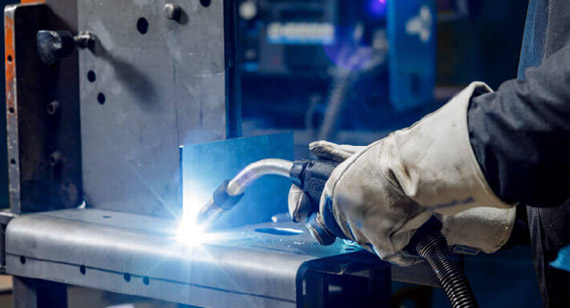15 years one-stop China custom CNC machining parts factory
 166 |
Published by VMT at Sep 23 2024
166 |
Published by VMT at Sep 23 2024
Welding is an essential process in the manufacturing industry, used to join metal components together in a durable and long-lasting way. Among the various welding techniques available, MIG (Metal Inert Gas) and TIG (Tungsten Inert Gas) welding are the two most popular methods. Both techniques are used across a wide range of industries, including automotive, aerospace, construction, and CNC precision machining. However, the choice between MIG and TIG welding depends on factors like the material being welded, the desired weld quality, and production requirements.
This article provides a detailed comparison of MIG welding vs. TIG welding, outlining the key differences, applications, advantages, and limitations of each method. By understanding the strengths and weaknesses of MIG and TIG welding, manufacturers can make informed decisions when choosing the best welding technique for their specific needs.
MIG and TIG welding are both arc welding processes that use electricity to create the heat required for welding. Despite their similarities, they differ significantly in terms of their power sources, materials, and the techniques involved. Here's a breakdown of the main differences between the two welding methods:
1. Power Source
MIG welding typically uses a constant voltage power source, making it more suitable for welding thicker materials. On the other hand, TIG welding uses a constant current power source, which provides more precise control over the welding arc. This allows TIG welding to excel in applications where precision is critical, especially for thin metals.
2. Material Compatibility and Thickness
MIG welding is more versatile when it comes to the types of materials it can handle. It works well with a range of metals, including steel, aluminum, and copper alloys. MIG welding is best suited for thicker materials due to its high heat input. In contrast, TIG welding is ideal for thinner materials such as stainless steel, aluminum, and titanium. Its ability to create clean, precise welds makes it perfect for applications where weld aesthetics and quality are paramount.
3. Type of Electrode Used
In MIG welding, a consumable wire electrode is fed through the welding gun, which melts and becomes part of the weld pool. TIG welding, on the other hand, uses a non-consumable tungsten electrode, which heats the metal without melting itself. A filler rod may be used in TIG welding, but it’s not always necessary. The use of a non-consumable electrode in TIG welding gives it more control over the weld.
4. Type of Shielding Gas
Both MIG and TIG welding require the use of shielding gas to protect the weld area from contamination by atmospheric gases such as oxygen and nitrogen. MIG welding commonly uses a mix of argon and carbon dioxide, whereas TIG welding typically uses pure argon or a mixture of argon and helium. The choice of shielding gas affects the quality and stability of the weld, with TIG welding providing a more refined shielding environment for precision work.
5. Gun Cooling System
MIG welding guns are generally air-cooled, which makes them suitable for short welding jobs or non-intensive applications. For longer, high-heat welding tasks, water-cooled MIG guns may be used. TIG welding torches are often air-cooled for light-duty work, but water-cooled systems are more common in industrial applications where prolonged welding is required.
6. Quality of Welded Parts
TIG welding is known for producing cleaner, higher-quality welds with minimal spatter. The process is slower but results in aesthetically pleasing welds with superior strength and integrity. MIG welding is faster and more suited to applications that prioritize speed over precision. However, MIG welds may produce more spatter and are generally less refined than TIG welds, especially in critical applications.

7. Productivity
MIG welding is generally more productive than TIG welding due to its faster speed and automation capabilities. MIG welding is often semi-automatic or fully automatic, making it ideal for long production cycles and mass production. TIG welding, while more precise, is slower and requires greater operator skill, which limits its productivity in high-volume production environments.
8. Cost
In terms of initial equipment costs, MIG welding is typically more affordable than TIG welding. The consumables used in MIG welding, such as wire electrodes, are also less expensive than the tungsten electrodes and filler rods used in TIG welding. However, the longer time required for TIG welding may increase labor costs, especially in projects requiring large volumes of welding.
Both MIG and TIG welding can be used on a variety of metals, but each technique has its strengths depending on the material being welded.
Stainless Steel
For stainless steel, TIG welding is generally preferred due to its ability to produce clean, precise welds with minimal contamination. TIG welding’s slower process gives the operator better control, resulting in aesthetically pleasing, high-strength welds. MIG welding, while faster, may produce more spatter and is often used when speed is a priority.
Mild Steel and Cast Iron
MIG welding is ideal for mild steel and cast iron, as it provides a fast and efficient method for joining these materials. The high heat input and faster welding speed make MIG welding suitable for thicker sections of steel, commonly used in construction and heavy manufacturing.
Aluminum
When welding aluminum, TIG welding is often the preferred method because it provides more control over the heat input, which is critical for preventing warping and distortion in thin aluminum sheets. However, MIG welding is also used for aluminum, particularly for thicker pieces where speed is a priority.
The components involved in TIG and MIG welding differ in terms of power supply, electrodes, and other equipment.
1. TIG Welding Components

Power: TIG welding uses a constant current power source, allowing for precise control of the welding arc, which is critical for delicate welding tasks.
Torch: The torch in TIG welding holds a tungsten electrode and directs the shielding gas to the weld area. It can be either air-cooled or water-cooled, depending on the welding task.
Foot Pedal: TIG welding often includes a foot pedal to control the amperage, giving the welder more control over the heat input.
Electrode and Shielding Gas: TIG welding uses a non-consumable tungsten electrode and typically relies on argon or a mix of argon and helium as the shielding gas.
Filler Material: Filler material is used as needed in TIG welding and is manually fed into the weld pool.
Support Rod: A support rod may be used for additional reinforcement, particularly when welding thicker materials.
2. MIG Welding Components

Power Supply: MIG welding uses a constant voltage power supply, which provides the high heat required for welding thicker materials.
Wires: A consumable wire is fed continuously through the MIG gun, acting as both the electrode and the filler material.
Electrode: The consumable electrode in MIG welding is a metal wire that melts into the weld pool to join the two metal pieces.
Torch: The MIG torch directs the wire electrode and shielding gas onto the weld area. MIG torches are generally air-cooled, but water-cooled options are available for more intensive applications.
Shielding Gas: MIG welding typically uses a blend of argon and carbon dioxide to shield the weld area from contaminants.
Principles of TIG Welding
TIG welding uses a non-consumable tungsten electrode to create an arc that heats the metal. The process may or may not require filler material, depending on the type of weld being performed. A shielding gas, typically argon, is used to protect the weld from contamination.
Advantages of TIG Welding
High precision and accuracy: TIG welding offers unmatched precision, making it ideal for intricate welding tasks and thin materials.
Provides quality welded joints and improves their aesthetics: TIG welding produces clean, high-quality welds with minimal spatter or defects.
Environmentally friendly: TIG welding produces less smoke and fewer harmful emissions than MIG welding.
Better control: The foot pedal and manual filler material feeding give the operator greater control over the weld.
Lower maintenance: Non-consumable tungsten electrodes reduce the need for frequent replacements, lowering maintenance costs.
Filler material is optional: TIG welding can be performed with or without filler material, offering flexibility depending on the application.
Material versatility: TIG welding can be used on a wide range of metals, including aluminum, stainless steel, and titanium.
Disadvantages of TIG Welding
Expensive: TIG welding equipment and consumables are more expensive than MIG welding.
Slow process: TIG welding is time-consuming compared to MIG welding, which may increase production costs.
Clean surface required: The welding surface must be clean and free of contaminants, adding preparation time.
Requires skill: TIG welding requires a high level of skill and experience to produce quality welds.
Applications of TIG Welding
Thin metals: TIG welding is ideal for welding thin materials where precision is critical.
Aluminum welding: TIG welding is often used for aluminum due to its control over heat input.
Short production runs: TIG welding is well-suited for custom or small-batch production runs where quality is more important than speed.
Aesthetic welds: TIG welding is used in applications where the appearance of the weld is important, such as in automotive and decorative metalwork.
Principles of MIG Welding
In MIG welding, a consumable wire electrode is continuously fed through the welding gun and melts into the weld pool. The process is shielded by an inert gas, typically a mixture of argon and carbon dioxide, which protects the weld from contaminants.
Advantages of MIG Welding
Fast and inexpensive: MIG welding is quicker than TIG welding, making it cost-effective for high-volume production.
Accurate: While not as precise as TIG welding, MIG welding still provides good accuracy for many applications.
Semi-automatic or fully automatic: MIG welding can be easily automated, increasing productivity in mass production environments.
Clean weld line: MIG welding produces a relatively clean weld line, with minimal spatter compared to other methods.
Weld at difficult angles: MIG welding is more flexible when welding at awkward or hard-to-reach angles.
Disadvantages of MIG Welding
Unreliable arc stability: MIG welding can suffer from arc instability, which may affect the quality of the weld.
Not environmentally friendly: MIG welding produces more smoke and emissions compared to TIG welding.
Not suitable for thin materials: MIG welding’s high heat can burn through thin metals, making it unsuitable for delicate work.
Weaker welds: MIG welds may not be as strong as TIG welds, especially for critical applications.
Applications of MIG Welding
Thick metal parts: MIG welding is commonly used for welding thicker sections of steel and other metals.
Low-defect parts: MIG welding is effective for producing parts with minimal defects in high-volume production.
Long production cycles: MIG welding is ideal for mass production and long welding runs where speed is a priority.
MIG is More Versatile
MIG welding is more versatile in terms of materials and applications. It’s suitable for a wide range of metals and can be used for both thin and thick materials. Additionally, it’s easier to use in various positions, including overhead and vertical welding.
MIG is Faster
For projects that require high-volume production or where speed is critical, MIG welding is the better choice. It’s faster than TIG welding and can be automated for even greater efficiency.
MIG is Simpler to Operate
MIG welding is easier to learn and operate than TIG welding, making it a good option for less experienced welders or environments where training time is limited.
Both MIG and TIG welding have their strengths and are suited for different types of projects. TIG welding is the go-to option for precision work, thin materials, and applications where aesthetics and weld quality are critical. MIG welding, on the other hand, offers faster production times and is more suitable for thicker materials and high-volume projects. The choice between MIG welding vs. TIG welding ultimately depends on the material, production requirements, and the specific goals of the project.
What are the main differences between MIG welding and TIG welding?
The primary differences are in the power source, electrode type, speed, and material compatibility. TIG is more precise but slower, while MIG is faster and better suited for thicker materials.
Is MIG or TIG better for welding aluminum?
TIG welding is generally preferred for aluminum because it provides better control over the heat input, which is important for preventing warping.
Should I choose riveting instead of welding?
Riveting may be a better option for some applications where welding is not feasible or if disassembly is required in the future.
Is TIG welding more difficult than MIG welding?
Yes, TIG welding is more difficult to master due to the level of precision and control required.
Which is better, MIG welding or TIG welding?
It depends on the application. MIG is better for high-volume, thicker materials, while TIG is better for precision work and thin metals.
What metals cannot be welded?
Metals such as cast iron, certain high-carbon steels, and some alloys may be difficult or impossible to weld effectively.
Can MIG weld aluminum?
Yes, MIG can weld aluminum, though TIG welding is often preferred for thin aluminum sheets.
What is the hardest metal for TIG welding?
Titanium is considered one of the more difficult metals to weld using TIG, due to its reactivity with oxygen at high temperatures.
